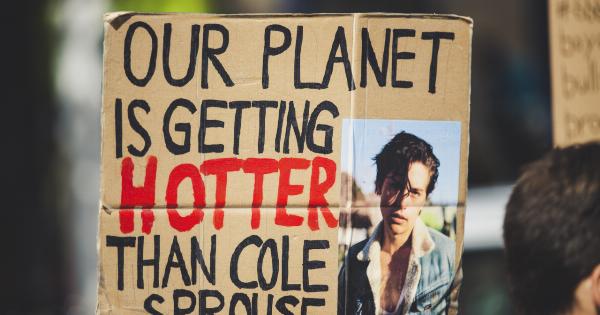The summer season is always eagerly anticipated by people around the globe. It means the arrival of sunshine, warmth, and long days to enjoy outdoor activities.
However, with global warming and climate change becoming increasingly prevalent, the traditional summer season is shifting. Some areas are getting hotter earlier, and others are experiencing delayed warmth.
In this article, we will explore several methods and technologies that can be used to delay the summer season, allowing areas to maintain their traditional seasonal patterns.
Effects of an Early Summer Season
While many people may welcome an early summer, it can have significant impacts on the environment and biodiversity.
Plants and animals are adapted to certain seasonal changes, and an increase in temperature too early can cause irreparable harm to ecosystems.
Additionally, an early summer season can lead to increased water usage, putting a strain on already limited resources. Unpredictable weather patterns can also affect the agricultural industry, making planning and forecasting much harder.
1. Surface Albedo Modification
Surface albedo modification, or SAM, is a method of reflecting sunlight back into space to cool the Earth. This can be achieved in several ways, but the most common is through the use of reflective surfaces.
Traditional roofing materials absorb heat, contributing to rising temperatures. However, using lighter and reflective materials can help reflect more of the sun’s rays back into the atmosphere, reducing temperatures.
This is a simple and effective solution that can help to delay the summer season. By installing reflective roofs and pavements, urban areas can lower temperatures and reduce the likelihood of heatwaves.
2. Cloud Seeding
Cloud seeding is a practice that involves adding materials to clouds in order to encourage precipitation. One of the side effects of this process is that it can also help to reduce temperatures by blocking some of the sun’s rays.
Cloud seeding has been used for decades to encourage rainfall in arid regions, but it can also help to delay the arrival of summer heat.
By increasing cloud cover and blocking some of the sun’s rays, areas can maintain cooler temperatures for longer periods.
3. Ocean Spraying
Ocean spraying is a relatively new concept that involves using remote-controlled boats and special nozzles to spray sea salt particles into the air. These particles can help to increase cloud cover and encourage precipitation, much like cloud seeding.
While this method is still being tested and refined, it has shown promising results. By increasing cloud cover and blocking some of the sun’s rays, it can help to delay the arrival of summer heat and reduce temperatures.
4. Urban Forestry
Urban forestry involves the planting and preservation of trees in cities and urban areas. Trees provide shade, reduce the amount of heat-absorbing surfaces, and help to increase moisture in the air.
This can help to reduce temperatures and make urban areas more comfortable during summer months.
By planting more trees in urban areas, cities can help to delay the arrival of summer heat and reduce temperatures overall.
Additionally, this can provide significant health benefits for residents, as trees help to improve air quality and reduce the risk of heat-related illnesses.
5. Green Roofs
Green roofs are similar to reflective roofs, but they involve actually planting vegetation on rooftops. This can help to reduce temperatures by providing shade and increasing the amount of moisture in the air.
Additionally, green roofs can provide significant environmental benefits, such as reducing stormwater runoff and improving air quality.
By implementing more green roofs in urban areas, cities can help to delay the arrival of summer heat and create more sustainable living spaces.
6. Changing Agricultural Practices
Agriculture is one of the industries most affected by unpredictable weather patterns. However, by changing certain agricultural practices, farmers can help to reduce the impact of an early summer season.
For example, practicing crop rotation can help to maintain soil moisture and reduce the amount of water usage needed for crops. Additionally, using more drought-resistant crops can help to reduce the impact of water shortages and heatwaves.
These small changes can add up to make a significant impact on the overall health and well-being of crops and the environment at large.
7. Cool Pavement Technologies
Cool pavement technologies involve the use of special materials to reflect sunlight and reduce temperatures. These materials can be used for pavements, parking lots, and roads.
By implementing cool pavement technologies, urban areas can help to delay the arrival of summer heat and reduce the likelihood of heatwaves.
Additionally, these materials can help to reduce the urban heat island effect, creating a more comfortable living space for residents.
8. Seawater Air Conditioning
Seawater air conditioning is a technology that involves using seawater to cool buildings.
This system pumps seawater from a relatively deep location, where it is significantly cooler, and circulates it through a heat exchanger to cool the air in a building.
This technology is particularly effective in coastal cities, where seawater is abundant. By using this technology, urban areas can reduce the amount of electricity needed for cooling buildings and delay the arrival of summer heat.
9. Smart Building Design
Smart building design involves designing buildings with energy-efficient technologies and materials. This can include things like efficient lighting systems, energy-efficient HVAC systems, and insulation.
By implementing smart building design, buildings can reduce their overall energy consumption, which in turn helps to reduce the amount of heat generated. This can help to delay the arrival of summer heat and reduce the impact of heatwaves.
10. Renewable Energy Sources
Renewable energy sources, such as solar and wind power, can help to reduce the amount of energy needed from traditional sources. This, in turn, helps to reduce the amount of heat generated from energy production.
By implementing more renewable energy sources, urban areas can help to reduce the impact of an early summer season and create a more sustainable living space for residents.
Additionally, renewable energy sources can help to reduce the likelihood of power outages during heatwaves, which can be life-threatening for vulnerable populations.
Conclusion
While the traditional summer season may be changing, there are several methods and technologies that can help to delay its arrival.
By implementing these solutions, urban areas can reduce the impacts of rising temperatures and create more sustainable living spaces for residents. Additionally, these solutions can help to reduce the likelihood of heatwaves and protect vulnerable populations.
It is important for governments, industries, and individuals to work together to implement these solutions and create a more sustainable and resilient future for all.



























